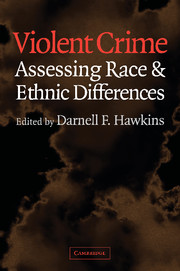Book contents
- Frontmatter
- Contents
- Contributors
- Foreword
- Editor's Introduction
- Violent Crime
- Part I Homicide Studies
- 1 Homicide Risk and Level of Victimization in Two Concentrated Poverty Enclaves: A Black/Hispanic Comparison
- 2 Moving Beyond Black and White Violence: African American, Haitian, and Latino Homicides in Miami
- 3 Homicide in Los Angeles County: A Study of Latino Victimization
- 4 Economic Correlates of Racial and Ethnic Disparity in Homicide: Houston, 1945–1994
- 5 The Race/Ethnicity and Poverty Nexus of Violent Crime: Reconciling Differences in Chicago's Community Area Homicide Rates
- Part II Other Contexts, Settings, and Forms of Violence
- Part III Explaining Racial and Ethnic Differences
- References
- Index
4 - Economic Correlates of Racial and Ethnic Disparity in Homicide: Houston, 1945–1994
Published online by Cambridge University Press: 22 August 2009
- Frontmatter
- Contents
- Contributors
- Foreword
- Editor's Introduction
- Violent Crime
- Part I Homicide Studies
- 1 Homicide Risk and Level of Victimization in Two Concentrated Poverty Enclaves: A Black/Hispanic Comparison
- 2 Moving Beyond Black and White Violence: African American, Haitian, and Latino Homicides in Miami
- 3 Homicide in Los Angeles County: A Study of Latino Victimization
- 4 Economic Correlates of Racial and Ethnic Disparity in Homicide: Houston, 1945–1994
- 5 The Race/Ethnicity and Poverty Nexus of Violent Crime: Reconciling Differences in Chicago's Community Area Homicide Rates
- Part II Other Contexts, Settings, and Forms of Violence
- Part III Explaining Racial and Ethnic Differences
- References
- Index
Summary
Introduction
An understanding of the diverse social factors that influence urban homicide has been sought since the pioneering work of Wolfgang (1958). Beginning with his analysis of 588 homicide victims and 621 offenders in Philadelphia during the years 1948–52, Wolfgang provided a detailed analysis of offenders and victims by race, sex, age, victim-offender relationships, and previous criminal records of either party. He also analyzed methods of killing, the degree of violence, the contribution of alcohol, and the motives of offenders for these homicidal incidents. Wolfgang's documentation of the marked differences by race and ethnicity of homicide victims and offenders has spawned an ongoing investigation into the question of what contributes to minorities' overrepresentation in urban killing.
This chapter begins with a review of findings from earlier studies of racial and ethnic differences in homicide at the city level. We then discuss racial and ethnic representation among Houston's homicides over the past fifty years and the role of the economy during each period. The chapter concludes with a discussion of questions that remain unanswered that may generate future research into the urban phenomenon of lethal violence.
Previous City-Level Homicide Research
There have been numerous city-level studies of homicide, both before and since Wolfgang's (1958) exemplary analysis of lethal violence in Philadelphia. Almost all of these studies, including that of Wolfgang, have reported considerable ethnic and racial disparity in rates of homicide in the United States (Bullock, 1955; Pokorny, 1965; Block, 1985, 1993; Martinez, 1996a).
- Type
- Chapter
- Information
- Violent CrimeAssessing Race and Ethnic Differences, pp. 67 - 88Publisher: Cambridge University PressPrint publication year: 2003
- 1
- Cited by

